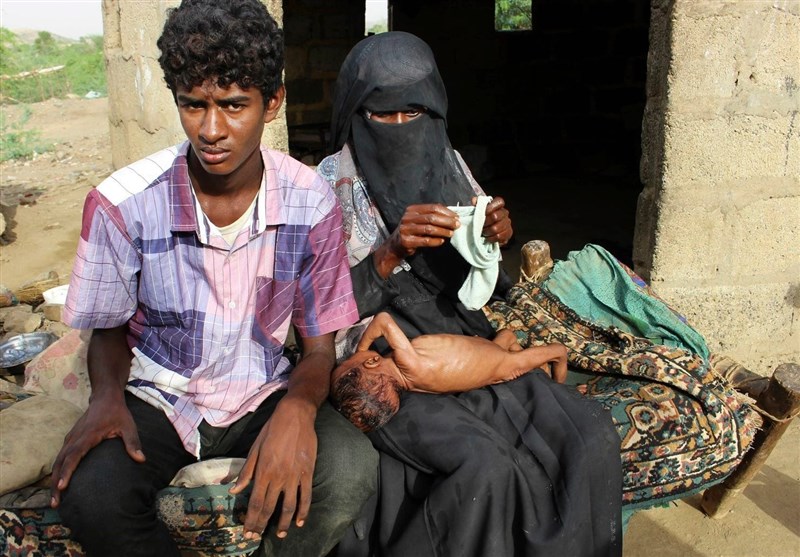Yemenis in Isolated Areas Eat Leaves to Survive Famine
TEHRAN (Tasnim) - International aid agencies have been caught off guard by the extent of the suffering of Yemeni families who have nothing to eat but the leaves of a local vine in a remote area in the north.
The Associated Press reported that people in the Aslam district of Yemen's northwestern Hajjah Province with Excruciatingly thin toddlers rely on leaves from the local vine, known as Halas in Arabic or Arabian Wax Leaf in English, due to worsening hunger.
At least 20 children are known to have died of starvation already this year in the province that includes the district, more than three years into the country’s ruinous civil war. The real number is likely far higher, since few families report it when their children die at home, officials say, Washington Post reported.
The worsening hunger in Aslam is a sign of the gaps in an international aid system that is already overwhelmed and under pressure from local authorities.
Yet outside aid is the only thing preventing widespread death from starvation in Yemen. The conditions in the district may also be an indication that humanitarian officials’ warnings are coming true: In the face of unending war, hunger’s spread is outstripping efforts to keep people alive.
When AP approached UN agencies with questions about the situation in Aslam, they expressed alarm and surprise. In response to the AP’s questions, international and local aid groups launched an investigation into why food wasn’t getting to the families that need it the most, a top relief official said.
As a response in the meantime, the official said, relief agencies are sending over 10,000 food baskets to the district, and UNICEF Resident Representative Dr. Meritxell Relano said the organization is increasing its mobile teams in the district from three to four and providing transportation to health facilities. The official spoke on condition of anonymity because of the sensitivity of issues involved in operating in the war-ravaged country.
In first six months of this year, Hajjah province, where Aslam is located, recorded 17,000 cases of severe acute malnutrition, higher than in any full year on record, said Walid al-Shamshan, head of the Health Ministry’s nutrition section in the province.
Malnourished children who are treated often go back to villages with no food and tainted water, then return to clinics in even worse condition — if they make it back at all.
“Deaths happen in remote villages where people can’t reach the health units,” al-Shamshan said. “It’s a steady deterioration and it’s scary.”
The number of people nationwide who would starve if they didn’t receive aid grew by a quarter over the past year, now standing at 8.4 million of Yemen’s 29 million people, according to UN figures. That number is likely to soon jump by another 3.5 million because the currency’s falling value leaves more people unable to afford food, the UN warned this month.
So far, the UN and its partners have only received about 65 percent of the $3 billion they sought for the humanitarian response in 2018.
Relief workers are further concerned over an assault by Saudi-led forces trying to take the Houthi-held Red Sea port city of Hudaydah. Nearly 80 percent of Yemen’s imports come through the port, including much of the humanitarian aid.
“Unless supply routes remain open this figure (of severely malnourished) could increase dramatically, putting the lives of thousands of children at risk from entirely preventable causes,” said Tamer Kirolos, Save the Children’s Yemen country director.
Aslam is one of Yemen’s poorest districts, with hundreds of small villages, some isolated in the high mountains in the Houthi heartland. Its population of 75,000 to 106,000 includes both local residents and accelerating numbers of people displaced from fighting elsewhere.
In terms of hunger, Aslam isn’t alone. Health officials say other districts closer to war zones may not be getting food aid at all. But Aslam saw one of the province’s highest jumps in the number of reported children suffering from severe acute malnutrition: From 384 cases being treated in January, an additional 1,319 more came in over the next six months, according to local health records. That comes to around 15 percent of the district’s children.
“Aslam is just another picture of Somalia,” said Saleh al Faqih, a worker in a mobile Health Ministry clinic, comparing it to the Horn of Africa nation often hit by famines.
Aslam’s main health center has no pediatricians, no electricity, no oxygen cylinders. At night, medics use flash lights because there is no fuel for generators. Fathers beg in the nearby market for 300 riyals — around 50 US cents — to buy a diaper for their child going into the center.
Before the war, the center would see one or two malnourished children a month. In August alone, it received 99 cases, nearly half in the most severe stages, the center’s nutrition chief Khaled Hassan said.
Food deliveries that do make it to Aslam come irregularly or are too small or are missing items, residents and aid workers said.
People in Aslam increasingly rely on leaves from the local vine, known in Yemeni Arabic as “halas” or in English as Arabian Wax Leaf. It used to be eaten only occasionally but now it’s all many residents eat for every meal. Mothers spend hours picking the leaves, then washing and boiling them. Too much of it causes diarrhea, as does the water it’s washed in — well water often tainted with sewage.






